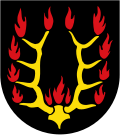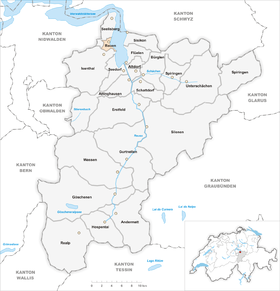Build UR
| UR is the abbreviation for the Canton of Uri in Switzerland and is used to avoid confusion with other entries in the name Bauen . |
| To build | |
|---|---|
| State : |
|
| Canton : |
|
| District : | No district division |
| BFS no. : | 1204 |
| Postal code : | 6466 |
| Coordinates : | 686 887 / 198997 |
| Height : | 436 m above sea level M. |
| Height range : | 433–1588 m above sea level M. |
| Area : | 3.80 km² |
| Residents: | 165 (December 31, 2018) |
| Population density : | 43 inhabitants per km² |
|
Proportion of foreigners : (residents without citizenship ) |
10.4% (December 31, 2,014) |
| Mayor : | Heidi Meier |
| Website: | www.bauen-ur.ch |
|
Build UR |
|
| Location of the municipality | |
Bauen is a municipality in the canton of Uri in Switzerland .
geography

The village is on the west bank of Lake Uri at the foot of the building blocks . The hamlet of Isleten, two kilometers southeast of the village, on the Isenthalerbach delta, belongs to the municipality .
Only 11 hectares or 2.9% of the community are settlement areas. Of this, 10 hectares are building or industrial areas and 1 hectare is traffic area. More important is the agricultural area with 51 ha or a share of 13.5%. These include hardly any alpine areas, but mainly meadow and arable land and fruit-growing areas. 284 hectares or 74.9% of the municipal area are covered by forest and wood, of which 259 hectares are forest. This is the highest proportion of forest areas in the entire canton. Unproductive areas cover the rest of the municipal area, namely 33 ha or 8.7%. These are mostly areas without vegetation (high mountains), areas with unproductive vegetation (high alpine vegetation) or bodies of water.
Bauen borders on Seelisberg to the north and west , Lake Lucerne to the east and Isenthal to the south .
population
Population development
The population fluctuated greatly from 1850 to 1960. The low point was in 1888 with 139 residents, the high point in 1941 with 208 residents. Overall, there was zero growth in the century between 1860 (184 residents) and 1960 (185 residents). Overall, the community was too isolated for immigration and emigration. But precisely this isolation was the reason for the emigration of young people between 1941 and 1970 (1941–1970: −24.5%). Because of the better transport connections and the beautiful location, strong growth began between 1970 and 2000 (1970–2000: +45.2%). Since then, the population has decreased significantly again (2000–2005: −15.8%) - but remains well above the population of previous years.
| Population development | |||||||||||||
|---|---|---|---|---|---|---|---|---|---|---|---|---|---|
| year | 1860 | 1888 | 1900 | 1920 | 1941 | 1960 | 1970 | 2000 | 2005 | 03/31/2014 | |||
| Residents | 184 | 139 | 167 | 189 | 208 | 185 | 157 | 228 | 192 | 176 | |||
languages
Almost the entire population speaks a high Alemannic dialect as everyday language. In the last census in 2000, 99% said German and 0.44% each Italian and Czech as their main language.
Religions - denominations
The population used to be fully members of the Roman Catholic Church. The denominational relationships in 2000 still show the original structure. 196 people were Catholic (86%). In addition, there were 8% Evangelical Reformed Christians and 5.26% non-denominational. Two people did not provide any information about their creed.
Origin - nationality
Of the 192 residents at the end of 2005, 182 (94.79%) were Swiss citizens. The majority of the immigrants come from Central Europe (Germany, Austria and Luxembourg) and from Southern Europe (Italy). At the 2000 census, 209 people (91.67%) were Swiss citizens; eleven of them had dual citizenship.
age structure
The church has a high percentage of younger people. While the proportion of people under the age of twenty makes up almost 30% of the local population, only just under 20% are senior citizens (60 years and older). This is a consequence of immigration between 1970 and 2000. However, the lack of young adults (20-29 years of age) is striking.
The last census in 2000 showed the following age structure:
| Age | 0–6 years | 7-15 years | 16-19 years | 20-29 years | 30–44 years | 45–59 years | 60–79 years | 80 years and more |
| number | 24 | 33 | 11 | 18th | 59 | 38 | 35 | 10 |
| proportion of | 10.53% | 14.47% | 4.82% | 7.89% | 25.88% | 16.67% | 15.35% | 4.39% |
politics
Legislature
The municipal assembly forms the legislature and usually meets twice a year.
Executive
The five-member municipal council forms the executive . He works part-time. The current mayor has been Mr. Andreas Gisler since January 1, 2018 (as of 2018).
coat of arms
Description : In black, a red flaming golden ten-end antler .
economy

In 1851 Carl Emanuel Müller built a paper mill on the Isleten, the then industrial area and a fraction of Bauen. Around 20 years later, the Swedish chemist Alfred Nobel , the founder of the Nobel Prize , and Karl Müller junior founded an explosives factory on the same site to produce dynamite on the basis of nitroglycerine . It was the eleventh factory of this type in the world and, based on contractual obligations, it delivered exclusively to the Swiss Confederation. The explosives were needed in Switzerland for civil purposes, mainly for the construction of the Gotthard tunnel, which began in 1872, as well as for the tunnels through the Axen and in the Urner Oberland. During the two world wars, the Swiss army was also one of the factory's customers, which at the time employed 100 to 150 workers. From 1875 onwards, the company produced the blasting gelatine invented by Nobel , which had 50 percent more explosive power than dynamite. After the factory changed hands twice, the production of explosives on Isleten stopped in 2003.
In 2005 there were eight farms offering 16 jobs. Industry and commerce employed 7 people in three workplaces, the service sector in seven companies 44 people (employment converted to full-time positions). The 2000 census showed eight agricultural and forestry businesses with 25 employees. The 2001 business census came to three industrial and commercial enterprises with 23 and eight service companies with 52 employees.
Of the 106 employed people in construction in 2000, 44 (41.51%) worked in their own municipality. In total, the place offered jobs to 73 people, of whom 44 (60%) were locals.
climate
Due to its location on the lake and the frequent foehn , Bauen has a very mild climate , so figs and palms thrive.
Attractions
Above the church, which is consecrated to St. Idda of Toggenburg , there is a memorial for Father Alberich Zwyssig , the composer of the Swiss Psalm , the Swiss national anthem .
literature
- Helmi Gasser : The art monuments of the canton Uri, Volume 2: The lakeside communities. Edited by the Society for Swiss Art History GSK. Bern 1986 (Art Monuments of Switzerland Volume 78). ISBN 3-7643-1811-2 . Pp. 317-358.
Web links
- Official website of the municipality of Bauen
- Informative website of a resident of Bauen
- Multimedia show
- Hans Stadler: Build. In: Historical Lexicon of Switzerland .
Individual evidence
- ↑ Permanent and non-permanent resident population by year, canton, district, municipality, population type and gender (permanent resident population). In: bfs. admin.ch . Federal Statistical Office (FSO), August 31, 2019, accessed on December 22, 2019 .
- ↑ pxweb.bfs.admin.ch
- ↑ luzernerzeitung.ch





